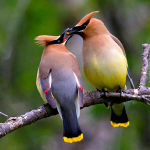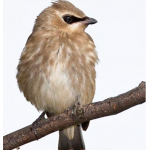How to Identify the Bohemian Waxwing

Valerie Assinewe, Professional Writing Program Intern
There are only three species in all but they look similar: the Bohemian Waxwing (Bombycilla garrulous), the Cedar Waxwing (Bombycilla cedrorum), and the Japanese Waxwing (Bombycilla japonica). Only the first two waxwings occur in North America whereas the Japanese Waxwing is found only in East Asia. I shall describe only the waxwings that you may see in Canada and the United States.
[separator headline=”h4″ title=”Adult Bohemian Waxwing description:”]
• Medium-sized: Length 19-23 cm; Wingspan 33 cm; Weight 55 g
• Brownish-gray plumage
• Backward-pointing crest on top of head
• Black mask from bill base through the eye and to rear of the head
• Eyes are dark brown
• White line arc below the eye
• Bill is black with pale base
• Head, crown and malar area are cinnamon to warm tawny
• Chin and throat are black
• White and yellow feather edging in wings
• Red waxy flatten tips on the secondary feathers appear like wax drops, for which the waxwings get their name
• Cinnamon under-tail coverts
• Black tail with bright yellow terminal band
• Legs and feet are dark grey to black.
Except for being smaller, the female is similar to the adult male.
The juvenile is duller and greyer than the adults with shorter crest, less extensive black mask and no black patch on the throat. The wing pattern is less conspicuous and the tail band is narrower. The underparts are whitish and slightly streaked brownish.
[separator headline=”h4″ title=”Adult Cedar Waxwing description:”]
• Medium-sized: Length 14-17 cm; Wingspan 22-30 cm; Weight 32 g
• Pale brown on the head and chest fading to soft gray on the wings
• Crest on top of head that often lies flat and droops over the back of the head
• Black mask outlined in white
• Belly is pale yellow
• Tertials have white inner edge
• Tail is gray with a bright yellow tip
• Red wax-like droplets tips the ends of the secondary feathers.
The only difference between the male and female Cedar waxwings is that the male has a black throat while the female’s is a dark brown.
Juveniles are streaked on the throat, breast, and flanks, and they have much duller white or yellow bellies, and unmarked dark wings—the red tips increase as the bird grows up. They usually lack the black mask of the adults and instead have white on their cheeks and behind their eyes.
[separator headline=”h2″ title=”Observation Tips”]
Do you have a range map? Bohemian Waxwings are migrant boreal songbirds. Although there are populations of Bohemian Waxwings that live year round in some areas of Alberta, British Columbia, and the Yukon; most of them migrate from their summer breeding grounds in the boreal forests of northwestern Canada to southern Canada and northwestern United States. IUCN provides a map of the global distribution of these waxwings.
When are you looking? If you are in southern Canada watching a flock of Waxwings and it’s March, then you are likely watching Bohemian Waxwings. However, if you are in the same area and watching a flock of Waxwings and it’s August, then you are likely watching Cedar Waxwings. I add “likely” for both scenarios in the event that you are in one of those areas that have that species year round.
Where should you go looking? The preferred habitat is open woodland with access to running water and food sources. Examples of ideal sites include parks, golf courses, landscaped commercial/industrial/apartment properties, college campuses, gardens and cemeteries that have berry plants used as ornaments and ponds or creeks to supply water for bathing and drinking.
What are the essentials to ID? It is unlikely that the bird will sit in a well-lit spot for you to use the full description above, so what are the essentials that you need for identification? There are several distinguishing features to quickly identify the two North American species. The adult Bohemian Waxwing has a gray belly, colourful wings, and cinnamon undertail coverts. The adult Cedar waxwing has a yellow belly and white undertail coverts. In addition, when the Cedar Waxwing is perched and viewed from behind, the tertials appear as two vertical white lines going partway up the bird’s back.
